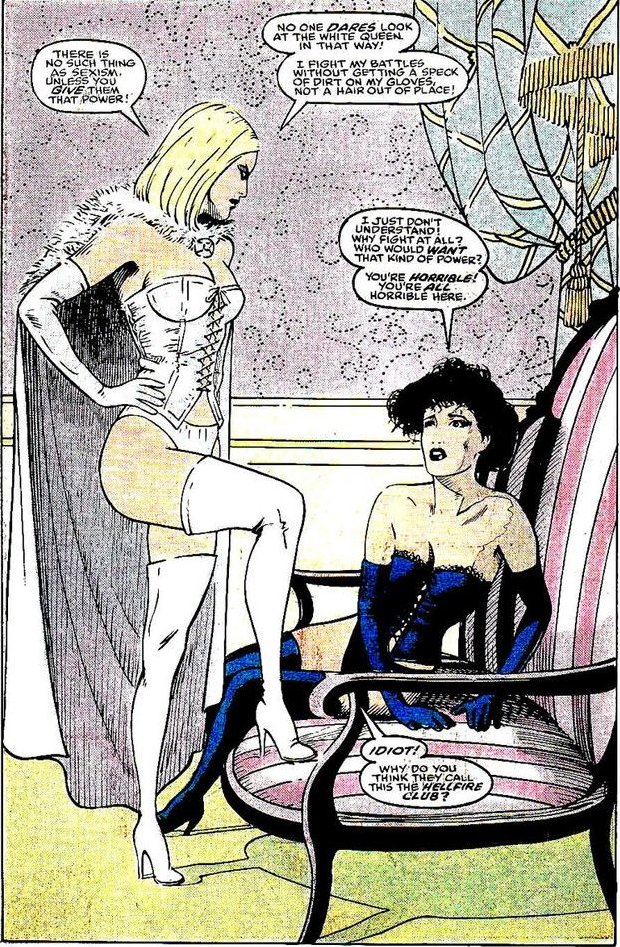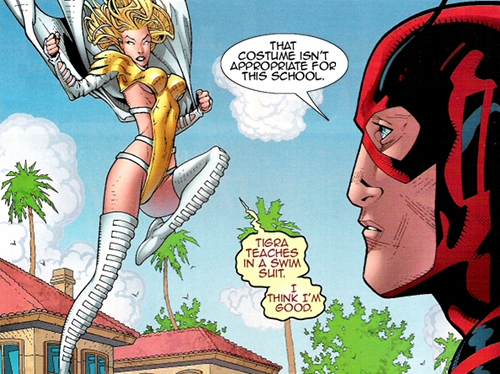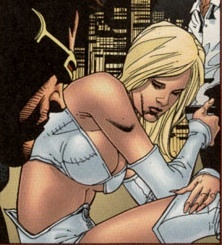Welcome to the X-Men, where second-skin garmentry is commonplace—hope you survive the experience!
Amongst the X-Men is a villain-turned-teacher (turned heroine, though never nice); her name is Emma Frost. For most of her history, she’s worn all-white, though recently she turned to all-black. But just as often as she’s been monochromatic, she’s been clothed in outfits that are overtly sex-suggestive.

Emma Frost is remarkable because nobody—fan nor creator nor Marvel management—will ever say, “No, you are wrong for thinking that this character has been designed to imply eroticism.” She’s not a perfect construct, but she’s something of a relief. At least, at last, we can talk about it. That’s probably why Grant Morrison put her front and centre in his New X-Men. In superhero comics—which he loves to remind us are about muscular men and large-breasted ladies in spandex and latex punching each other through walls—Emma Frost is established as a mouthpiece for those who would sit at the back, whispering, “Isn’t this all a bit rude? Where are everybody’s sexy bits?” Here they are! They’re on Emma. She is our erotic scapegoat.
Emma Frost made her debut in 1980. She’s a creation of Chris Claremont and John Byrne—of course she is. From the get-go, she’s an ice blonde stricture-bitch, a sadistic psychic villainess with contempt for her own team dressed in thigh-high stiletto boots and an outfit that makes depilation a professional expense. She’s the White Queen of the Hellfire Club, which is a sort of horny, evil, minor Illuminati. In 1989, Ann Nocenti (script) and John Bolton (art) gave us this scene, where Emma defines her outfit in her own words. This scene is returned to, again and again, to explain why it’s okay, in fact reasonable, in fact good, for Emma Frost to be drawn wearing intimates as a matter of course. Get your rubber stamps, boys: It’s not sexist! Emma says so!

The White Queen, it seems, does not entertain the thought of sexism as a negative at all. But Emma’s not been the White Queen for a long time, and she stepped away from the Hellfire Club as the centre of her on-page operations long before that. A mutant, an intellectual who thrives on mentorship (who needs boardroom bondage imagery when you can literally mould minds? The smart teacher is the power behind myriad thrones—and as a psychological bonus, a generous mind is much healthier to live with than one devoted to secrets and betrayal), Emma Frost has been written to survive comas and battles and calamitous rejection. She’s seen students die in her care, and Marvel creative establishes that this wounds her deeply and informs her subsequent growth. She has become an uncompromising, fallible force for justice and progression. Emma Frost loves deeply and intuits how to help those around her to better mental and emotional health. If you’re a danger to her people or cause, she can hide around the corner and use her mind to make you destroy yourself. Those are facts of her written existence.

So why does her wardrobe still rely on her villainous, aggressive costume detailing? Why—if the time and care is taken to write and compose her character with what integrity is possible in a medium that spends three and a half decades on the adulthoods of characters who are yet to crack thirty—does dressing her like “Sexy Halloween” despite her life circumstances (high school teacher, adventurer, and business woman) remain the norm?
Because of sexism! Tricked you!
Sorry, darling. Emma Frost’s White Queen outfit always was expressed sexism. In-universe, the Hellfire Club demands women dress in restrictive lingerie if they’re to hope to be present. In-universe, Emma Frost recognises that for what it is: hazing. The costume is designed to trap her, but she’s noticed the trap, placed herself into it with care, and now lies in wait for he who set it.
Within the story, either the Hellfire rulemaker/couturier is a person who believes that women have a place (“beneath and in service”), or they are a person who does not shy from using established social obstacles (misogyny, shame, fear of rape—you know, woman stuff) to test prospective high-level members. Either way: they’re performing sexism. They’re integrating sexism into their organisation.

Throughout her published history, Emma Frost is single-minded. She’s headed for power, and she believes herself singular: see how she suggests institutional dehumanisation (a sexist dresscode) can be a tool for personal victory (“it’s all about PERSONAL DOMINATION”). She regards every battle as a personal one, which she alone may either win or lose. She considers the world her oyster because she must: for Emma Frost to be able to succeed in reining the Hellfire’s influence, it must be theoretically possible for Emma Frost to be able to achieve this. She won’t allow the possibility of impossibility; therefore, no obstacle is real, because she can overcome it.
It can’t diminish Emma Frost to be required to dress to a sexist menu, because if Emma Frost can be diminished, the house of cards that is her gameplan crumbles. Men seek to reduce women, and to reduce Emma Frost personally (it’s revealed in this same issue that visitors to the Club often mistake her for a waitress, not recognising a leader—comics published years later imagine, or reveal, her younger years to have been a horror show of abusive patriarchs). Either men can beat her down or they can’t. If hardship and humiliation are able to leave their mark, then she is covered with marks. Emma Frost regards herself as the White Queen. No marks. A spotless diamond field. Why would she allow her confidence to waver? Because you feel bad about the disrespect you (whisper it: also) receive?
Emma Frost, the White Queen, does not entertain the thought of sexism as a negative. But there’s a “because”: fighting against the social disease of sexism does not provide a battle she can win. Social justice is irrelevant to her life, so don’t ask her to respond to the philosophy of it.
The most generous, that’s-just-her-taste reading of this 1989 scene, is that even apart from the machinations and mental chess, the character just does not care about who sees her in this outfit. Some people are chill about communal nudity; some people welcome viewers as they perform sexuality. Happy pornographers are real; nudists also. So maybe Emma Frost doesn’t mind wearing knickers and a lace-up bodice with thigh-high boots in a closed club. Maybe, under Nocenti’s direction, she chose to digress on the philosophy of personal versus institutional exploitation just to teach the new waitress a thing or two about thought experiments. None of these options would make the Hellfire set-up non-sexist.
Contextually sexist things happen to contextually humanised characters. These things are different and concurrent.
But even if Frost were, beyond argument, a character at peace with public nudity or professional objectification, she doesn’t have the privilege to refuse this outfit. It’s a uniform that’s required by whim, not necessity, for the performance of her job. Comics published later tell us that she began work at the Club as a stripper, wearing this same outfit—at that point, her job was to titillate, and so the outfit was designed for the work at hand. But now she is the White Queen, and the King wears britches, cravat, shirt, and coat. It’s hard to find neutrality or the love-yourself message of the feminist porn artiste, in sexuality weaponised for a hostile, gendered environment. For all of her dimension and innate dignity, Emma Frost, the character, is treated poorly by her peers (imagine, a brilliant woman, undervalued).
Now, redux all of that, but with the awareness of Emma Frost as a constructed character, created and regularly sustained by men, in a masculine environment. Rachel Dodson has inked her—has any woman artist ever defined Emma Frost’s body or clothing? Move past her Hellfire HQ days: Emma Frost conducts Headmistress duties in shiny white smalls. Wait. Why?

Recall her potted explanation of the bodice, knickers and sex boots: “My LOOKS and BODY are WEAPONS on par with a man’s FISTS.” When White Queen Emma Frost conducts supervillainy in and amongst the Hellfire Club, when she angles for power and manipulates those close around her, she calls her sexual beauty something dangerous. For this character to align her image with sexual display is to be aggressive and controlling. A look at her breast curve is a punch in the face. That’s her metaphor, elaborated. She’s explicit that her outfit is an offensive gambit (swallow that joke, NERD).
Why is she sexually punching her orphaned refugee teenaged pupils? A school is not a war ground! What motivation are we supposed to infer?
Emma is one of the few Marvel characters with any kind of consistent aesthetic, and it’s not surprising to see it go unchallenged, or spring back to this form, for this long. It’s eye-catching, continuity has its own agreeable charm, and Marvel comics approves of sexual drawings of women. What it’s not is good storytelling. What once was explained, and coherent, now is not.
Environmentally, even, the Hellfire location was a huge loss for team lingerie.
The Hellfire Club is all heavy carved furniture, log fires, dark skies outside and probably dungeons. They have stone walls and weighty curtains—their entire visual steez is Hammer Throwback. “You Know, The Past.” It’s all about faked up heritage and legacy authority and oppression. Visual oppression. Actual oppression. Hazing and mind games and arm-twisting. In an environment like that, a clever, determined woman with spare flesh and fine bones, fetish lingerie and red lipstick might begin an advance and seem overwhelming. In an environment like that, intimacy is enforced; Emma Frost is working with localised rape culture. She’s dressed up to batter you, sir, with her commonly denominated eroticism. Take away the walls and the set dressing, and what have you got? A weird chick in her bra and pants. More what’s she doing running around like that? than good heavens, forgive me, I think I have to give in to her.
We’ve seen how her personal relationships are heavy on the psychosexual provocation angle. She’s a psychic; she can suck your face wearing your wife’s old dress in your shared imagination-space, and she’s a physical human, so she can lean, and smile, and make veiled comments, and do all of the seductive whatever that anybody can do wearing anything. Wearing anything. Look again at Emma and Scott, Emma and Namor, Emma and anybody.
Tell me that her sort of come-on would be ineffective if she were wearing a) a floral silk blouse, b) lime green dungarees, c) old flannels, or d) a weird high-fashion structured wool tunic. Don’t make me laugh. Emma can work you. It’s in her character.
WWAC contributor Lindsey tells me that Sunstone suggests Emma is a fetishist; that her choice of outfit services her own deep psychology and she’s enacting I feel sexy so I feel powerful rather than I’m aware you think I look sexy, therefore I’m powerful. This is a reasonable conjecture supported by the decades of stick-on corsetry, but not inspired or supported by her creative patriarchs. It doesn’t emerge from the scene I began with. Emma Frost, at-work fetish queen, is a viable product of years and years of careless hypersexualisation. Fetishists, however, are not generally so desperately driven by compulsion that they cannot pick their moments. Fetishists, by and large, do not indulge themselves whilst teaching vulnerable charges. Because that would be criminal.

But the dominant narrative is, and I’m not sure if this originally emerged from anywhere but vague inference-by-omission and reader interpretation, that Emma Frost dresses “like that” because she knows it makes her look hot, and she’s had plastic surgery to look hot (as “a dominatrix from hell,” thanks Granto), and she loves to look hot, because looking hot makes you powerful. The dominant narrative is that she wants priapic power without shelling out any of her own intimate energy; she’s uninterested in fucking you, but you’re interested in fucking her, so you’ll carry her books or something, I don’t know. Does the Sexy Trick angle ever work?
If creative agreement is that somebody does something in order to gain a benefit, then the benefit should either be shown materialising or a change should be addressed. If we’re to agree that underwear in public makes X-Men enemies fumble the ball, that’s what we need to see regularly. (Caveat: that will be sexist.)
When actually did Emma Frost last win a victory because her fabled hands-free dick-manipulation worked?
Occasionally, characters stumble when confronted with the aggro undies. Women. Younger woman characters, to whom Emma is a figure of authority: these people are affected by her outfits. Presumably they are intimidated, unnerved or confused, and reminded of sex, sexism, or both. They say unkind things to Emma in front of their peers and other people under her care. Internalised misogyny! Great! There’s a problem I’ll trust the Make Mine Male Marvel establishment with, ha, ha, ha. Even if one did, though: what’s in it for Emma? Why would this character seek to sow discord amongst the women she leads? Why base their distance in sexuality? Do you really want to explain a flagship character with “she dresses like a wet dream so that the women who look up to her feel discomfort and publicly belittle her”? Whatchu doing with that, Marvel? What’s up?
There’s not actually a character-based reason for the chronology of corsetry, the plethora of PVC, or the barrage of cleavage. Not one I can find. Emma Frost has character, and she has motivation and reputation. Hard, calculated, ambitious taskmaster who understands children, responsibility, and bad decisions. A good teacher. A dedicated caretaker. These traits are not served by the artists who clothe her. Emma Frost deals in taunts, certainly, but I push is not spoken only, or best, by adhesives, straps, or riding crops.
Sexual aggression in high school teachers is not a joke, and a refusal to visually reassess Emma Frost forces it to become one. Emma’s uniforms are sexist, they’re unreasonable, out of character, and inappropriate. Marvel: do you keep them because hot for teacher (and she’s hot back) is a pornographic motif you’re reluctant to lose? Is it the Claremontian lust for yes/no, the hopeful reader’s pleasure (a woman with a calling beyond super heroics!)/pain (and she’s engineered for the lech’s gaze!) that allows you to sell the idea of this woman, this teacher, as a product, emphasising inappropriate mastery and boundary pushes, shying away from honest reassessment of what dedication to education might mean? The vast majority of teachers are sexual individuals. Only the appalling, relative few bring sexual aggression into the student-teacher relationship. Is Emma Frost your porno fantasy bitch, or is she a character who matters?

I don’t believe in her, as you present her to me. She doesn’t add up. Change something.
This post was guest-edited by F. Stewart-Taylor is a comics fan, researcher and theorist. Her standup has been compared to The Smiths; her popculture writing has not.








